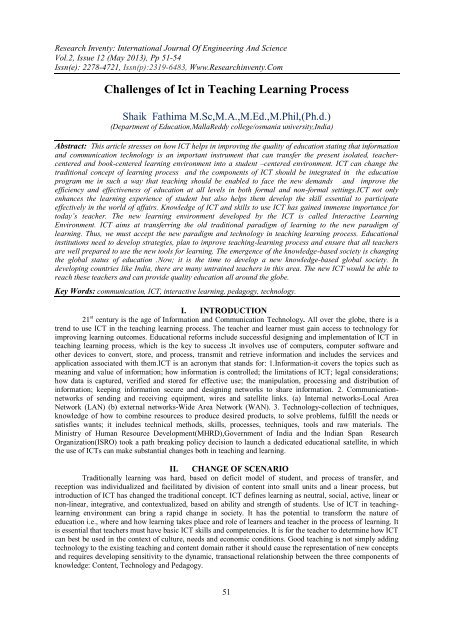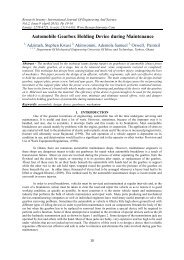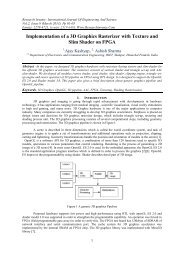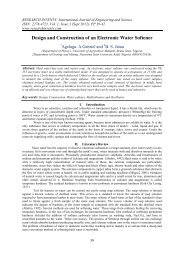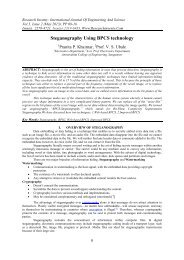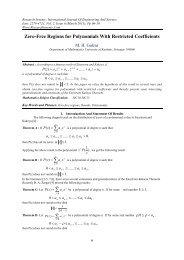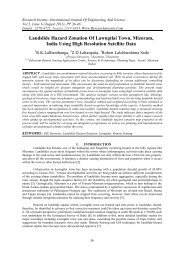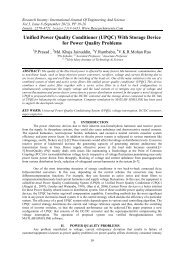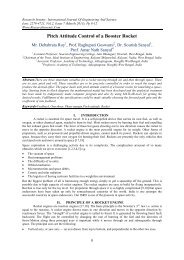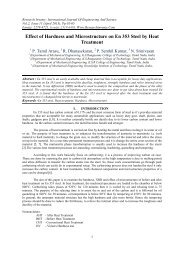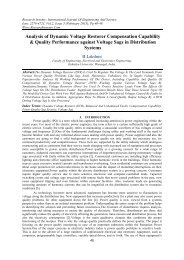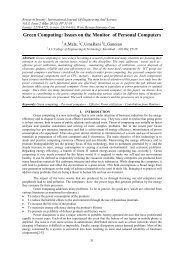Challenges of Ict in Teaching Learning Process - Research Inventy
Challenges of Ict in Teaching Learning Process - Research Inventy
Challenges of Ict in Teaching Learning Process - Research Inventy
Create successful ePaper yourself
Turn your PDF publications into a flip-book with our unique Google optimized e-Paper software.
<strong>Research</strong> <strong>Inventy</strong>: International Journal Of Eng<strong>in</strong>eer<strong>in</strong>g And Science<br />
Vol.2, Issue 12 (May 2013), Pp 51-54<br />
Issn(e): 2278-4721, Issn(p):2319-6483, Www.<strong>Research</strong><strong>in</strong>venty.Com<br />
<strong>Challenges</strong> <strong>of</strong> <strong>Ict</strong> <strong>in</strong> Teach<strong>in</strong>g Learn<strong>in</strong>g <strong>Process</strong><br />
Shaik Fathima M.Sc,M.A.,M.Ed.,M.Phil,(Ph.d.)<br />
(Department <strong>of</strong> Education,MallaReddy college/osmania university,India)<br />
Abstract: This article stresses on how ICT helps <strong>in</strong> improv<strong>in</strong>g the quality <strong>of</strong> education stat<strong>in</strong>g that <strong>in</strong>formation<br />
and communication technology is an important <strong>in</strong>strument that can transfer the present isolated, teachercentered<br />
and book-centered learn<strong>in</strong>g environment <strong>in</strong>to a student –centered environment. ICT can change the<br />
traditional concept <strong>of</strong> learn<strong>in</strong>g process and the components <strong>of</strong> ICT should be <strong>in</strong>tegrated <strong>in</strong> the education<br />
program me <strong>in</strong> such a way that teach<strong>in</strong>g should be enabled to face the new demands and improve the<br />
efficiency and effectiveness <strong>of</strong> education at all levels <strong>in</strong> both formal and non-formal sett<strong>in</strong>gs.ICT not only<br />
enhances the learn<strong>in</strong>g experience <strong>of</strong> student but also helps them develop the skill essential to participate<br />
effectively <strong>in</strong> the world <strong>of</strong> affairs. Knowledge <strong>of</strong> ICT and skills to use ICT has ga<strong>in</strong>ed immense importance for<br />
today’s teacher. The new learn<strong>in</strong>g environment developed by the ICT is called Interactive Learn<strong>in</strong>g<br />
Environment. ICT aims at transferr<strong>in</strong>g the old traditional paradigm <strong>of</strong> learn<strong>in</strong>g to the new paradigm <strong>of</strong><br />
learn<strong>in</strong>g. Thus, we must accept the new paradigm and technology <strong>in</strong> teach<strong>in</strong>g learn<strong>in</strong>g process. Educational<br />
<strong>in</strong>stitutions need to develop strategies, plan to improve teach<strong>in</strong>g-learn<strong>in</strong>g process and ensure that all teachers<br />
are well prepared to use the new tools for learn<strong>in</strong>g. The emergence <strong>of</strong> the knowledge-based society is chang<strong>in</strong>g<br />
the global status <strong>of</strong> education .Now; it is the time to develop a new knowledge-based global society. In<br />
develop<strong>in</strong>g countries like India, there are many untra<strong>in</strong>ed teachers <strong>in</strong> this area. The new ICT would be able to<br />
reach these teachers and can provide quality education all around the globe.<br />
Key Words: communication, ICT, <strong>in</strong>teractive learn<strong>in</strong>g, pedagogy, technology.<br />
I. INTRODUCTION<br />
21 st century is the age <strong>of</strong> Information and Communication Technology. All over the globe, there is a<br />
trend to use ICT <strong>in</strong> the teach<strong>in</strong>g learn<strong>in</strong>g process. The teacher and learner must ga<strong>in</strong> access to technology for<br />
improv<strong>in</strong>g learn<strong>in</strong>g outcomes. Educational reforms <strong>in</strong>clude successful design<strong>in</strong>g and implementation <strong>of</strong> ICT <strong>in</strong><br />
teach<strong>in</strong>g learn<strong>in</strong>g process, which is the key to success .It <strong>in</strong>volves use <strong>of</strong> computers, computer s<strong>of</strong>tware and<br />
other devices to convert, store, and process, transmit and retrieve <strong>in</strong>formation and <strong>in</strong>cludes the services and<br />
application associated with them.ICT is an acronym that stands for: 1.Information-it covers the topics such as<br />
mean<strong>in</strong>g and value <strong>of</strong> <strong>in</strong>formation; how <strong>in</strong>formation is controlled; the limitations <strong>of</strong> ICT; legal considerations;<br />
how data is captured, verified and stored for effective use; the manipulation, process<strong>in</strong>g and distribution <strong>of</strong><br />
<strong>in</strong>formation; keep<strong>in</strong>g <strong>in</strong>formation secure and design<strong>in</strong>g networks to share <strong>in</strong>formation. 2. Communicationnetworks<br />
<strong>of</strong> send<strong>in</strong>g and receiv<strong>in</strong>g equipment, wires and satellite l<strong>in</strong>ks. (a) Internal networks-Local Area<br />
Network (LAN) (b) external networks-Wide Area Network (WAN). 3. Technology-collection <strong>of</strong> techniques,<br />
knowledge <strong>of</strong> how to comb<strong>in</strong>e resources to produce desired products, to solve problems, fulfill the needs or<br />
satisfies wants; it <strong>in</strong>cludes technical methods, skills, processes, techniques, tools and raw materials. The<br />
M<strong>in</strong>istry <strong>of</strong> Human Resource Development(MHRD),Government <strong>of</strong> India and the Indian Span <strong>Research</strong><br />
Organization(ISRO) took a path break<strong>in</strong>g policy decision to launch a dedicated educational satellite, <strong>in</strong> which<br />
the use <strong>of</strong> ICTs can make substantial changes both <strong>in</strong> teach<strong>in</strong>g and learn<strong>in</strong>g.<br />
II. CHANGE OF SCENARIO<br />
Traditionally learn<strong>in</strong>g was hard, based on deficit model <strong>of</strong> student, and process <strong>of</strong> transfer, and<br />
reception was <strong>in</strong>dividualized and facilitated by division <strong>of</strong> content <strong>in</strong>to small units and a l<strong>in</strong>ear process, but<br />
<strong>in</strong>troduction <strong>of</strong> ICT has changed the traditional concept. ICT def<strong>in</strong>es learn<strong>in</strong>g as neutral, social, active, l<strong>in</strong>ear or<br />
non-l<strong>in</strong>ear, <strong>in</strong>tegrative, and contextualized, based on ability and strength <strong>of</strong> students. Use <strong>of</strong> ICT <strong>in</strong> teach<strong>in</strong>glearn<strong>in</strong>g<br />
environment can br<strong>in</strong>g a rapid change <strong>in</strong> society. It has the potential to transform the nature <strong>of</strong><br />
education i.e., where and how learn<strong>in</strong>g takes place and role <strong>of</strong> learners and teacher <strong>in</strong> the process <strong>of</strong> learn<strong>in</strong>g. It<br />
is essential that teachers must have basic ICT skills and competencies. It is for the teacher to determ<strong>in</strong>e how ICT<br />
can best be used <strong>in</strong> the context <strong>of</strong> culture, needs and economic conditions. Good teach<strong>in</strong>g is not simply add<strong>in</strong>g<br />
technology to the exist<strong>in</strong>g teach<strong>in</strong>g and content doma<strong>in</strong> rather it should cause the representation <strong>of</strong> new concepts<br />
and requires develop<strong>in</strong>g sensitivity to the dynamic, transactional relationship between the three components <strong>of</strong><br />
knowledge: Content, Technology and Pedagogy.<br />
51
<strong>Challenges</strong> Of <strong>Ict</strong> In Teach<strong>in</strong>g…<br />
FIG: RELATIONSHIP BETWEEN CONTENT, TECHNOLOGY AND PEDAGOGY KNOWLEDGE<br />
<br />
<br />
<br />
<br />
<br />
<br />
<br />
<br />
III. INTEGRATION OF ICT IN TEACHING LEARNING<br />
TECHNOLOGY LITERACY Basic digital literacy skills to use technology, ability to select and use<br />
appropriate s<strong>of</strong>tware available <strong>in</strong>clud<strong>in</strong>g <strong>in</strong>ternet <strong>in</strong> computer laboratories or with limited classroom<br />
facilities to complement standard curriculum objectives, assessment approaches, lesson plans and didactic<br />
teach<strong>in</strong>g methods, able to use ICT to manage classroom data and support their own pr<strong>of</strong>essional<br />
development.<br />
KNOWLEDGE DEEPENING Ability to manage <strong>in</strong>formation, structure problem tasks, <strong>in</strong>tegrate openended<br />
s<strong>of</strong>tware tools and subject specific applications with student centered teach<strong>in</strong>g methods and<br />
collaborative methods and collaborative projects <strong>in</strong> support <strong>of</strong> students deep understand<strong>in</strong>g <strong>of</strong> key concepts<br />
and their application to solve complex world real problems, use network resources to help students<br />
collaborate, access <strong>in</strong>formation, communicate with experts to analyze and solve their selected problems and<br />
use ICT to create and monitor <strong>in</strong>dividual group plans.<br />
KNOWLEDGE CREATION Design ICT-based learn<strong>in</strong>g resources and environments use ICT to support<br />
the development <strong>of</strong> knowledge creation and critical th<strong>in</strong>k<strong>in</strong>g skills <strong>of</strong> students, support students’ cont<strong>in</strong>uous<br />
reflective learn<strong>in</strong>g, and create knowledge communities for students and colleagues.<br />
IMPACT IN CLASSROOM Opportunities to deploy <strong>in</strong>novative teach<strong>in</strong>g methodologies and to deploy<br />
more <strong>in</strong>terest<strong>in</strong>g material that create an <strong>in</strong>terest <strong>in</strong> the students, enable better management <strong>of</strong> classroom and<br />
students there by improv<strong>in</strong>g the productivity <strong>of</strong> the tutor as well as the taught, enables the teacher to<br />
concentrate on other tasks such as research and consultancy, enables optimum utilization and shar<strong>in</strong>g <strong>of</strong><br />
resources among <strong>in</strong>stitutions thereby reduc<strong>in</strong>g the cost <strong>of</strong> implement<strong>in</strong>g ICT solution and to f<strong>in</strong>d<br />
appropriate onl<strong>in</strong>e resources that can be used <strong>of</strong>fl<strong>in</strong>e or converted to a paper based resource. Ex-NRICH<br />
website <strong>of</strong>fers enrichment materials for mathematics to pupils <strong>of</strong> all ages.<br />
IV. STEPS TAKEN TO INTEGRATE ICT<br />
Eleventh Five- Year Plan (2007-2012) importance <strong>of</strong> ICT <strong>in</strong> education has been emphasized.<br />
“National Curriculum Framework”(2005) emphasized the judicious use <strong>of</strong> technology to <strong>in</strong>crease the reach<br />
<strong>of</strong> educational program , facilitate management <strong>of</strong> the system as well as address specific learn<strong>in</strong>g needs and<br />
requirements.<br />
Government <strong>of</strong> India has set up a national task force on <strong>in</strong>formation technology and s<strong>of</strong>tware development<br />
to universalize computer literacy.<br />
Intel Teach to future program is a world wide effort to <strong>in</strong>tegrate technology <strong>in</strong> classroom.<br />
4.1 ORGANIZING ACTIVITIES FOR LEARNERS THROUGH ICT<br />
Through ICT students can experience various stages <strong>of</strong> learn<strong>in</strong>g, such as critical th<strong>in</strong>k<strong>in</strong>g, problem<br />
solv<strong>in</strong>g, guided <strong>in</strong>struction, extra connect, cooperative learn<strong>in</strong>g and group monitor<strong>in</strong>g.<br />
<br />
<br />
Simulations-provide excellent opportunities for teachers to create sett<strong>in</strong>gs where students are led through<br />
critical th<strong>in</strong>k<strong>in</strong>g stages.<br />
Guided <strong>in</strong>structions-allows students to submit pieces <strong>of</strong> a project step by step, allow<strong>in</strong>g for a rich feedback<br />
<strong>in</strong>teraction between students and <strong>in</strong>structor. A problem like Textra connect or lotus notes allow draft essays<br />
to be submitted and returned.<br />
52
<strong>Challenges</strong> Of <strong>Ict</strong> In Teach<strong>in</strong>g…<br />
<br />
<br />
<br />
<br />
Cooperative learn<strong>in</strong>g-websites provide ready sites for discussions, cooperative groups are designed and<br />
assigned to do the activities by monitor<strong>in</strong>g these groups, and the <strong>in</strong>structor can <strong>in</strong>troduce timely prompts to<br />
redirect the conservation, pos<strong>in</strong>g problems that challenge the quo.<br />
Acceleration-children can be accelerated with<strong>in</strong> their own class work<strong>in</strong>g <strong>in</strong>dependently, <strong>of</strong>ten with some<br />
additional support.<br />
Extension-mov<strong>in</strong>g outside the syllabus normally not covered <strong>in</strong> the curriculum.<br />
Enrichment-extend<strong>in</strong>g students understand<strong>in</strong>g and apply<strong>in</strong>g them to other situations and problems to<br />
develop higher level problem solv<strong>in</strong>g and communication skills.<br />
V. ICT USAGE IN TEACHING LEARNING MATHEMATICS<br />
It is quite possible to use ICT <strong>in</strong> mathematics lessons <strong>in</strong> a way that mathematics curriculum support<strong>in</strong>g<br />
IT group, produced the ways <strong>in</strong> which ICT can provide opportunities for students learn<strong>in</strong>g mathematics. This<br />
will enable students to manipulate diagrams dynamically and encourage them to visualize the geometry as they<br />
generate their own mental images.<br />
Learn<strong>in</strong>g from feedback-the computer <strong>of</strong>ten provides fast and reliable feedback, which is non-judgmental<br />
and impartial. This can encourage students to make their own conjectures and to test out and modify their<br />
ideas.<br />
Observ<strong>in</strong>g patterns-the speed <strong>of</strong> computers and calculators enable student to produce many examples when<br />
explor<strong>in</strong>g mathematical problems. This supports their observation <strong>of</strong> patterns and the mak<strong>in</strong>g and justify<strong>in</strong>g<br />
<strong>of</strong> generalizations.<br />
See<strong>in</strong>g connections-the computer enables formulae, tables <strong>of</strong> numbers and graphs to be l<strong>in</strong>ked readily.<br />
Chang<strong>in</strong>g one representation and see<strong>in</strong>g changes <strong>in</strong> the other helps students to understand connections<br />
between them.<br />
Work<strong>in</strong>g with dynamic images-students can use computers to manipulate diagrams dynamically. This<br />
encourages them to visualize the geometry as they generate their own mental images.<br />
Explor<strong>in</strong>g data-computers enable students to work with real data, which can be represented <strong>in</strong> variety <strong>of</strong><br />
ways. This supports <strong>in</strong>terpretation and analysis.<br />
Teach<strong>in</strong>g the computer-when students design an algorithm to make the computer achieve a particular result,<br />
they are compelled to express their commands unambiguously and <strong>in</strong> the correct order; they make their<br />
th<strong>in</strong>k<strong>in</strong>g explicit as they ref<strong>in</strong>e their ideas.<br />
5.1 ICT-AN AID IN MATHEMATICAL CONCEPT AND SKILL DEVELOPMENT<br />
It enhanced power to deal with multiple representations via ICT- Ex. Symbolic, numerical and graphical<br />
representations <strong>of</strong> functions <strong>in</strong> algebra.<br />
It enhanced ability to visualize via ICT-Ex. Manipulations through s<strong>of</strong>tware packages <strong>of</strong> 3-dimensional<br />
objects such as solids <strong>of</strong> revolution by calculus students as an aid <strong>in</strong> develop<strong>in</strong>g spatial visualization skills.<br />
It enhanced opportunity to construct mathematics knowledge via <strong>in</strong>dividual and group <strong>in</strong>vestigation us<strong>in</strong>g<br />
technologies-Ex. discovery <strong>of</strong> geometric properties by students via geometry s<strong>of</strong>tware.<br />
It enhanced opportunity for <strong>in</strong>dividualized and customized diagnosis, remediation and evaluation- Ex.<br />
computer-aided <strong>in</strong>struction for algebra students hav<strong>in</strong>g difficulty with factor<strong>in</strong>g.<br />
5.2 MATHEMATICAL PROBLEM SOLVING<br />
It enhanced the ability to focus on the process <strong>of</strong> problem solv<strong>in</strong>g <strong>in</strong>stead <strong>of</strong> the computational aspect-Ex.<br />
calculus students us<strong>in</strong>g a computer algebra system to perform numerical <strong>in</strong>tegration as one step <strong>in</strong> a multistep<br />
applied problem.<br />
It enhanced ability to solve realistic problems <strong>in</strong>stead <strong>of</strong> be<strong>in</strong>g restricted to contrived problems hav<strong>in</strong>g<br />
solutions-Ex. algebra students solv<strong>in</strong>g problem whose model is a cubic equation via the aid <strong>of</strong> graph<strong>in</strong>g<br />
calculator.<br />
It enhanced opportunity for students to be <strong>in</strong>troduced to <strong>in</strong>terest<strong>in</strong>g problems and associated mathematical<br />
subject matter much earlier than before possible-Ex. Students solv<strong>in</strong>g optimization problems via computer<br />
or calculator generated graphs or estimat<strong>in</strong>g probabilities via computer simulations.<br />
It <strong>in</strong>creased opportunity to develop mathematical model<strong>in</strong>g skills-Ex. student’s programm<strong>in</strong>g a computer to<br />
model a card hand us<strong>in</strong>g <strong>in</strong>tegers and thus calculate expected values <strong>of</strong> carnival games <strong>in</strong>volv<strong>in</strong>g car hands.<br />
53
<strong>Challenges</strong> Of <strong>Ict</strong> In Teach<strong>in</strong>g…<br />
5.3 MATHEMATICAL REASONING<br />
It enhances ability to gather data <strong>in</strong> order to form conjectures and apply <strong>in</strong>ductive reason<strong>in</strong>g-Ex. Use <strong>of</strong><br />
calculator by students to f<strong>in</strong>d number patterns.<br />
It enhanced motivation to th<strong>in</strong>k logically <strong>in</strong> order to program a calculator or computer to perform desired<br />
tasks-Ex. students study<strong>in</strong>g discrete mathematics programm<strong>in</strong>g a calculator to <strong>in</strong>vestigate the solution <strong>of</strong> a<br />
difference equation.<br />
5.4 MATHEMATICAL COMMUNICATION<br />
It enhanced motivation to communicate mathematics precisely <strong>in</strong> order to perform a desired tasks-Ex.<br />
Algebra students programm<strong>in</strong>g a computer to estimate the probability that a quadratic equation has real<br />
roots under vary<strong>in</strong>g conditions on the coefficients.<br />
It enhanced ability for the students to present mathematical ideas both orally and <strong>in</strong> writ<strong>in</strong>g-Ex.use <strong>of</strong> word<br />
processors to write reports which <strong>in</strong>clude mathematical symbols, tables and graphs and use <strong>of</strong> multimedia<br />
programs to communicate mathematical ideas.<br />
Generic s<strong>of</strong>tware and open ended tasks that will engage students who are struggl<strong>in</strong>g but <strong>of</strong>fer real opportunities<br />
for stretch<strong>in</strong>g the most able s<strong>of</strong>tware such as logo, dynamic geometry s<strong>of</strong>tware and spreadsheets all have this<br />
potential but closed .Skill based s<strong>of</strong>tware doesn’t give the flexibility to encourage enrichment.<br />
VI. CONCLUSION<br />
Emergence <strong>of</strong> <strong>in</strong>formation and communication technology has ushered a new era <strong>in</strong> our civilization <strong>in</strong><br />
which digitalization has almost become a better alternative, because it has <strong>in</strong>fluenced every facet <strong>of</strong> human life<br />
<strong>in</strong>clud<strong>in</strong>g education. Transformation should take place <strong>in</strong> the way our teachers teach and students learn. The<br />
efforts <strong>of</strong> ICT is generally <strong>of</strong> sporadic nature <strong>in</strong> the education program .Teachers <strong>in</strong> India need to be prepared to<br />
face the challenges <strong>of</strong> 21 st century for impart<strong>in</strong>g the new age education; hence education program <strong>in</strong> India<br />
should <strong>in</strong>tegrate ICT component <strong>in</strong> such a way that teachers are enabled to face the new demands <strong>in</strong> their<br />
pr<strong>of</strong>ession. Efforts must be made by the educationist to change the process <strong>of</strong> teach<strong>in</strong>g-learn<strong>in</strong>g <strong>in</strong> order to<br />
prepare the students to adjust themselves to the society; this could def<strong>in</strong>itely create a new learn<strong>in</strong>g environment<br />
and <strong>in</strong>formation rich society.<br />
REFERENCES<br />
[1] Aggrawal,J.C.(2003).Educational technology and Management. New Delhi: v<strong>in</strong>od Pustak Mandir.<br />
[2] Banks Frank (1994) .Teach<strong>in</strong>g Technology. London: Routledge.<br />
[3] Bhaskara Rao (2004). Methods <strong>of</strong> Teach<strong>in</strong>g Educational Technology. New Delhi: Discovery Publish<strong>in</strong>g House.<br />
[4] Biswas, P.C. (2002). Build<strong>in</strong>g ICT skills for Quality Teacher Education. University News, 40(50), 16-22.<br />
[5] Jansson,C.,Karlgren,K.,Naeve,A. & Nilsson,M.(2002) Personalized and Shared Mathematics Courselets. PADLR Progress<br />
Report.<br />
[6] Koehler Mathew,J., Mishra Punya (2005).What Happens When Teachers Design Educational Technology The Development <strong>of</strong><br />
Technological Pedagogical Content Knowledge. Journal <strong>of</strong> Education Comput<strong>in</strong>g <strong>Research</strong>, 32(2), 131-152.<br />
[7] Neelam Yadav (2003). A Hand book <strong>of</strong> Educational Technology. New Delhi: Anmol Publications Pvt.Ltd.<br />
[8] Shukla , C.(2008). Essentials <strong>of</strong> educational technology and management. New Delhi: Dhanpatrai Publications<br />
[9] UNESCO (2002). .Information and Communication Technologies <strong>in</strong> Teacher Education. A Plann<strong>in</strong>g Guide: UNESCO<br />
Publication.<br />
[10] UNESCO (2008). ICT Competency Standards for Teachers. UNESCO.<br />
[11] Venkataiah, N. (1995).Educational technology. New Delhi: Atul Publishers.<br />
54


